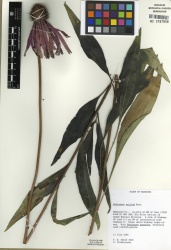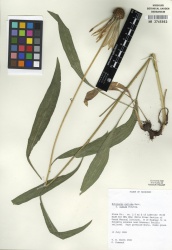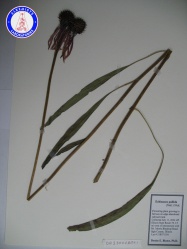Echinacea pallida (root)
(add HPTLC method to distinguish between echinacea varieties) |
|||
| (12 intermediate revisions by 2 users not shown) | |||
| Line 1: | Line 1: | ||
| − | + | {{DISPLAYTITLE:''Echinacea pallida'' (root)}} {{askbox|herb=''Echinacea pallida''}} [[Category:Botanical]] | |
| − | '' | + | =Nomenclature= |
| + | {{nomenclature | binomial=Echinacea pallida | ||
| + | |authority=(Nutt.) Nutt. | ||
| + | |family=Asteraceae | ||
| + | |scn=''Echinacea pallida'' | ||
| + | |syn= | ||
| + | |ayurvedic= | ||
| + | |pinyin= | ||
| + | |aka=pale-flower echinacea; pale purple coneflower | ||
| + | |notes=}} | ||
| + | =Botanical Voucher Specimen= | ||
| − | + | {{Media3 |cat=Voucher | |
| + | |||
| + | | source=MOBOT, Tropicos.org | ||
| + | | mainimage=Echinacea_pallida_Tropicos_89110.jpg | ||
| + | | companyimage=TropicosLogo.gif | ||
| + | | companyURL=http://www.tropicos.org/Image/89110 | ||
| + | | reference=Tropicos.org. Missouri Botanical Garden. 25 Mar 2014 <http://www.tropicos.org/Image/89110> | ||
| − | + | | source2=MOBOT, Tropicos.org | |
| + | | image2=Echinacea_pallida_Tropicos_89104.jpg | ||
| + | | companyimage2=TropicosLogo.gif | ||
| + | | companyURL2=http://www.tropicos.org/Image/89104 | ||
| + | | reference=Tropicos.org. Missouri Botanical Garden. 25 Mar 2014 <http://www.tropicos.org/Image/89104> | ||
| − | + | | source3=Botanical Voucher Specimen Library, Alkemists Laboratories | |
| + | | image3=Echinacea pallida OA23004BMX1 A0103.jpg | ||
| + | | companyimage3=AP-LOGO-Laboratories Crop - Copy.jpg | ||
| + | | companyURL3=http://www.alkemist.com | ||
| − | + | | }} | |
| − | + | ||
| − | + | ||
| − | + | ||
| − | + | ||
| − | + | ||
| − | + | ||
| − | | | + | |
| − | =Microscopic | + | =Organoleptic Characteristics= |
| − | + | ||
| − | + | =Macroscopic Characteristics= | |
| − | + | ||
| − | = | + | =Microscopic Characteristics= |
| − | = | + | |
| + | =High Performance Thin Layer Chromatographic Identification= | ||
| + | |||
| + | =Supplementary Information= | ||
| + | ==HPTLC method, Schicke, ''et al.'', 2014== | ||
| + | '''A sensitive TLC method to identify Echinaceae pallidae radix.''' | ||
| + | <blockquote>'''Abstract.''' | ||
| + | |||
| + | In this work a fast, simple and sensitive qualitative TLC method was developed to identify Echinaceae pallidae radix and to distinguish this drug from similar ones. The TLC method is based on the lipophilic compounds of E. pallida. Three mobile phases provided good separation, e.g. toluene/ethylacetate 7 + 3 (v/v). A marker substance was found which shows a blue fluorescence at an excitation wavelength of 366 nm after detection with a spray agent containing 95 volume parts ethanol 96%, 5 parts trifluoroacetic acid 99% and zinc ions in 0.15 molar concentration. After spraying the chromatogram was heated at 110 degrees C for 7 min. This method is superior to HPLC methods to characterise mixtures of Echinacea extracts in terms of selectivity due to this post-chromatographic derivatisation and subsequent fluorescence detection.<ref> | ||
| + | Schicke B., Hagels H., Freudenstein J., Wätzig H. 2004. A sensitive TLC method to identify Echinaceae pallidae radix. ''Pharmazie.'' 59(8):608-11. http://openurl.ingenta.com/content/nlm?genre=article&issn=0031-7144&volume=59&issue=8&spage=608&aulast=Schicke</ref></blockquote> | ||
| + | =Sources= | ||
| + | |||
| + | <references /> | ||
Latest revision as of 20:11, 20 August 2015
Contents |
[edit] Nomenclature
Echinacea pallida (Nutt.) Nutt. Asteraceae
Standardized common name (English): Echinacea pallida
[edit] Botanical Voucher Specimen
 |
||
|
|
|
|
[edit] Organoleptic Characteristics
[edit] Macroscopic Characteristics
[edit] Microscopic Characteristics
[edit] High Performance Thin Layer Chromatographic Identification
[edit] Supplementary Information
[edit] HPTLC method, Schicke, et al., 2014
A sensitive TLC method to identify Echinaceae pallidae radix.
Abstract. In this work a fast, simple and sensitive qualitative TLC method was developed to identify Echinaceae pallidae radix and to distinguish this drug from similar ones. The TLC method is based on the lipophilic compounds of E. pallida. Three mobile phases provided good separation, e.g. toluene/ethylacetate 7 + 3 (v/v). A marker substance was found which shows a blue fluorescence at an excitation wavelength of 366 nm after detection with a spray agent containing 95 volume parts ethanol 96%, 5 parts trifluoroacetic acid 99% and zinc ions in 0.15 molar concentration. After spraying the chromatogram was heated at 110 degrees C for 7 min. This method is superior to HPLC methods to characterise mixtures of Echinacea extracts in terms of selectivity due to this post-chromatographic derivatisation and subsequent fluorescence detection.[4]
[edit] Sources
- ↑ MOBOT, Tropicos.org http://www.tropicos.org/Image/89110
- ↑ MOBOT, Tropicos.org http://www.tropicos.org/Image/89104
- ↑ Botanical Voucher Specimen Library, Alkemists Laboratories http://www.alkemist.com
- ↑ Schicke B., Hagels H., Freudenstein J., Wätzig H. 2004. A sensitive TLC method to identify Echinaceae pallidae radix. Pharmazie. 59(8):608-11. http://openurl.ingenta.com/content/nlm?genre=article&issn=0031-7144&volume=59&issue=8&spage=608&aulast=Schicke


